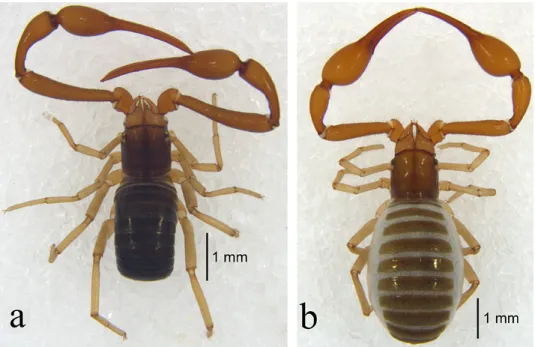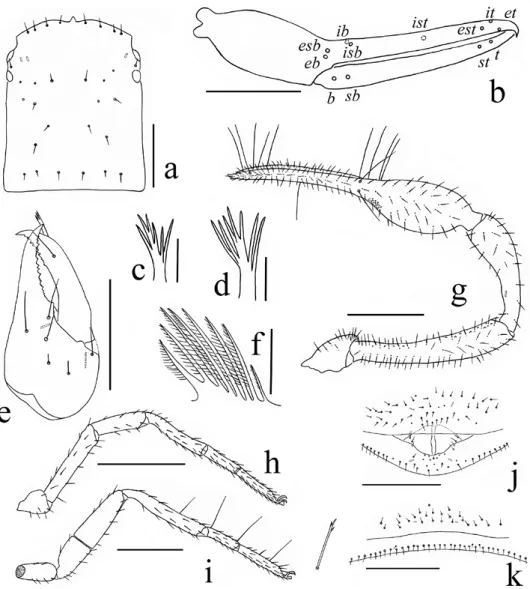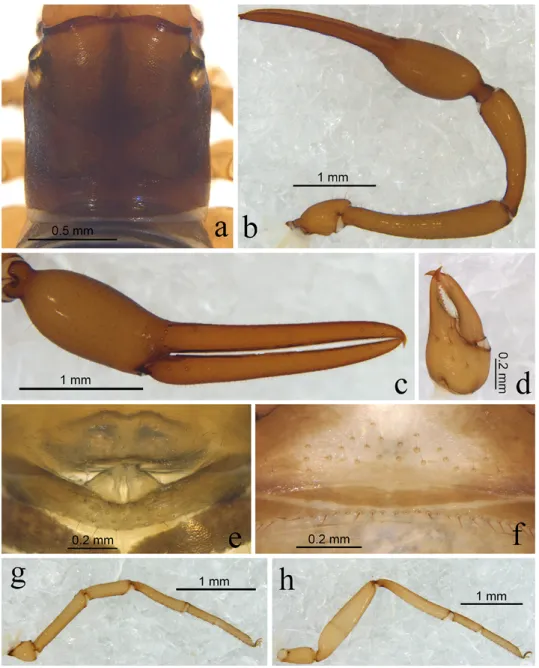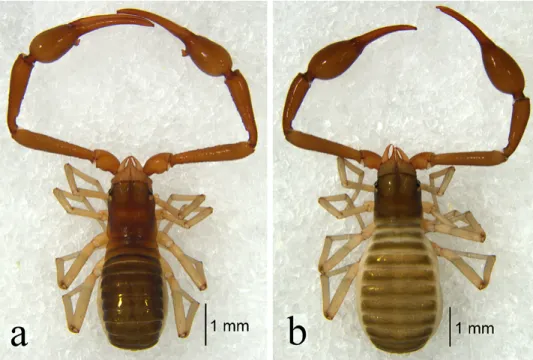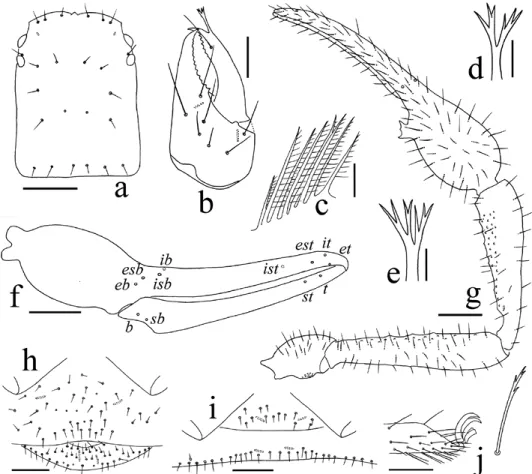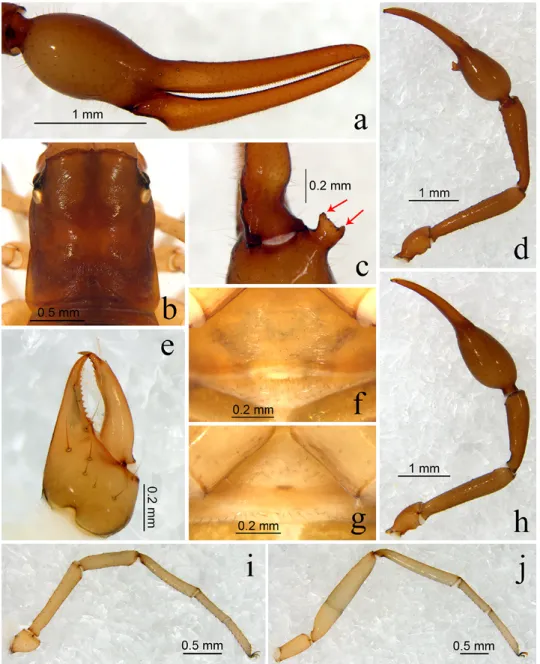TWO NEW STENOHYA SPECIES (PSEUDOSCORPIONES:
NEOBISIIDAE) FROM THE GAOLIGONG MOUNTAINS, SOUTHWESTERN CHINA
Xiangbo Guo1, 2, Xiao Zang1,3 and Feng Zhang1,4
1The Key Laboratory of Invertebrate Systematics and Application, College of Life Sciences Hebei University, Baoding, Hebei 071002, P. R. China
2E-mail: xiangboguo@163.com, https://orcid.org/0000-0002-7074-8642
3E-mail: 18832287323@163.com, https://orcid.org/0000-0001-8718-1876
4The Museum of Hebei University, Baoding, Hebei 071002, P. R. China E-mail: dudu06042001@163.com, https://orcid.org/0000-0002-3347-1031
Two new Stenohya species (Neobisiidae) are described from southwestern China: Stenohya arcuata sp. n. and Stenohya bicornuta sp. n., both from the Gaoligong Mountains, Yunnan Province. Detailed diagnoses, descriptions and illustrations of the two new species are presented.
Key words: Arachnida, taxonomy, pseudoscorpion.
INTRODUCTION
Stenohya Beier, 1967 is an Asian pseudoscorpion genus of the family Neo- bisiidae Chamberlin, 1930. It includes 17 species at present (Harvey 2013, Hu
& Zhang 2012, Yang & Zhang 2013, Mahnert & Li 2016, Guo & Zhang 2016), of which eight species have been reported from China: S. curvata Zhao, Zhang et Jia, 2011, S. xiningensis Zhao, Zhang et Jia, 2011, S. huangi Hu et Zhang, 2012, S. pengae Hu et Zhang, 2012, S. tengchongensis Yang et Zhang, 2013, S.
meiacantha Yang et Zhang, 2013, S. hainanensis Guo et Zhang, 2016 and S. setu- losa Guo et Zhang, 2016. They largely live in leaf litter, with the exception of S.
pengae living in the canopy layer (Hu & Zhang 2012).
The Gaoligong Mountains is a sub-range of the southern Hengduan
Mountain Range, located in the western Yunnan highlands and straddling the
border between southwestern China and northern Burma. It is well known for
its rich flora and fauna of plants and wildlife, and belongs to one of “biodiver-
sity hotspots” for conservation priorities (Myers et al. 2000). During examina-
tion of pseudoscorpion specimens collected by sieving leaf litter from Gaoli-
gong Mountains, two previously unknown Stenohya species were found. They
are described and illustrated here as S. arcuata sp. n. and S. bicornuta sp. n.
MATERIAL AND METHODS
All specimens were examined and illustrated using a Leica 205A stereomicroscope with a drawing tube, which was also used for the measurements. Detailed examination was carried out with an Olympus BX53 general optical microscope. Temporary slide mounts were prepared in glycerol. Figures were edited and formatted using Adobe Photoshop CC. The specimens are preserved in 85% alcohol and deposited in the Museum of Hebei University (MHBU), Baoding, China.
Terminology and mensuration largely follow Chamberlin (1931), except for the no- menclature of the pedipalps and legs, and the terminology of trichobothria (Harvey 1992), the term “rallum” (for flagellum) is adopted following Judson (2007).
TAXONOMY Stenohya arcuata sp. n.
(Figs 1–3)
Type material. Holotype male (Ps.-MHBU-YN14041301), China: Yunnan Province, Baoshan City, Gaoligong Mountains (25°18’N, 98°47’E), alt. 2345 m, 13 April 2014, leg.
Xuankong Jiang. Paratypes: one male and three females (Ps.-MHBU- YN14041302–05), col- lected with holotype.
Etymology. The specific name is derived from the Latin word “arcuatus”, meaning
“arched”, refers to the incurved pedipalpal femur and patella in male.
Diagnosis. Carapace with 4 well-developed eyes, epistome triangu- lar; apex of pedipalpal coxa with 4 long setae; male pedipalpal femur and patella incurved (female pedipalpal femur straight, patella curved at base);
male pedipalpal femur 5.44–5.56 (female 4.23–4.45), patella 3.38–3.49 (female 2.81–2.86), chela (with pedicel) 4.83–4.97 (female 3.50–3.74) times longer than broad; male fixed chelal finger with 137–141 (female 124–129) small, cusped teeth; movable finger with 120–124 (female 115–118) small teeth.
Description of males (Fig. 1a) – Carapace and abdomen almost black, pedipalps, chel- icera and legs brown. Setae of body straight and acicular.
Carapace (Figs 2a, 3a). Entirely smooth, 1.14–1.16 times longer than broad, with total of 30 setae, including 8 near anterior margin and 6 near posterior margin; 3–4 lyrifissures near the eyes; epistome triangular; with 4 corneate eyes.
Chelicera (Figs 2e, 3d). Hand with 6 setae and 2 lyrifissures, movable finger with 1 seta situated sub-medially; fixed finger with 14–16 teeth; movable finger with 8 teeth; ser- rula exterior with 37 lamellae; serrula interior with 30–32 lamellae; galea with 6 terminal rami (Fig. 2c); rallum consisting of 8 blades, all with anteriorly-directed spinules, the basal- most blade shortest (Fig. 2f).
Pedipalps (Figs 2b, 2g, 3b, 3c). Apex of pedipalpal coxa rounded, with 4 long setae.
Femur incurved, with several tubercles prolaterally; patella incurved, smooth; chelal hand with coarse granulation on medial surface near the base of fixed chelal finger; trochanter
1.43–1.83, femur 5.44–5.56, patella 3.38–3.49, chela (with pedicel) 4.83–4.97, chela (without pedicel) 4.57–4.64 times longer than broad, movable finger 1.50 times longer than hand (with pedicel). Fixed chelal finger with 8, movable finger with 4 trichobothria: eb, esb, ib and isb located basally, et, est and it situated distally, ist almost at middle of fixed finger;
trichobothria t and st in distal fourth, b and sb in basal fourth of movable finger. Venom ap- paratus present only in fixed chelal finger, duct very short. Fixed chelal finger with 137–141 small, cusped teeth, movable finger with 120–124 small teeth, cusped only in distal tenth of finger.
Abdomen. Pleural membrane granulated. Tergites and sternites undivided, tergal chaetotaxy (I–XI): 8–9: 12: 11–12: 12: 12–14: 12: 10: 10–11: 12: 11: 5, sternal chaetotaxy (IV–
XI): 22–24: 25: 22: 23: 21: 17–19: 16: 12; in addition, sternites VI–VIII with 7–9 medial scat- tered glandular setae; sternite III with 8, sternite IV with 7 setae along anterior margin of each stigmata; anal cone with 2 dorsal and 2 ventral setae. Genital area (Figs 2j, 3e): sternite II with total of 46–49 setae and 2 lyrifissures; sternite III with 13 setae and 2 lyrifissures an- teriorly, 25–26 setae on posterior margin. Genitalia with 8 setae on posterior genital plate.
Legs. Leg I (Figs 2h, 3g) and leg IV (Figs 2i, 3h) typical. Tibia IV with a sub-medial tactile seta (TS = 0.67–0.70), basitarsus IV with 2 tactile setae situated basally and distally (TS = 0.07, 0.85), telotarsus IV with a sub-medial tactile seta (TS = 0.60). Subterminal tarsal seta with 3 branches; arolium not divided, shorter than the slender, simple claws.
Description of females (Fig. 1b) – As in holotype, except where noted.
Chelicera. Fixed finger with 14 teeth; movable finger with 7 teeth; serrula exterior with 35–37 lamellae; serrula interior with 28–29 lamellae; galea with 7 terminal rami (Fig. 2d).
Fig. 1. Stenohya arcuata sp. n.: a = holotype male, habitus, dorsal view; b = paratype female, habitus, dorsal view
Pedipalps. Femur straight, with several tubercles prolaterally; patella smooth, curved at base; chela smooth; trochanter 1.63–1.73, femur 4.23–4.45, patella 2.81–2.86, chela (with pedicel) 3.50–3.74, chela (without pedicel) 3.27–3.54 times longer than broad, movable fin- ger 1.34–1.39 times longer than hand (with pedicel); fixed chelal finger with 124–129 small, cusped teeth, movable finger with 115–118 small teeth, cusped only in distal fifth of finger.
Abdomen. Tergal chaetotaxy (I–XI): 6: 8–9: 11–12: 12: 12: 11–12: 12: 12: 13–14: 13: 8, sternal chaetotaxy (IV–XI): 21–22: 26: 22: 22–24: 22: 20: 17–18: 13; in addition, sternites VI–
Fig. 2. Stenohya arcuata sp. n., holotype male (a–c, e–j), paratype female (d, k): a = carapace, dorsal view; b = right chela, lateral view (showing trichobothriotaxy); c = galea; d = galea;
e = right chelicera, dorsal view; f = rallum; g = right pedipalp, dorsal view; h = right leg I, lateral view; i = right leg IV, lateral view (subterminal seta magnified); j = genital area; k =
genital area. Scale bars: 0.10 mm (c, d, f); 0.50 mm (a, e, j, k); 1.00 mm (b, g–i)
VIII with 2 medial glandular setae. Genital area (Figs 2k, 3f): sternite II with 24–25 setae and 2 lyrifissures; sternite III with a row of 36 setae along posterior margin.
Fig. 3. Stenohya arcuata sp. n., holotype male (a–e, g, h), paratype female (f): a = carapace, dorsal view; b = right pedipalp, dorsal view; c = right chela, lateral view; d = right chelicera, dorsal view; e = genital area; f = genital area; g = right leg I, lateral view; h = right leg IV,
lateral view
Measurements (in mm; ratios in parentheses are length/breadth or, for legs, length/
depth). Male. Body length 3.86–3.94. Carapace 1.16–1.35/1.02–1.11 (1.14–1.16×). Chelicera 0.80–0.84/0.43 (1.86–1.95×), movable finger length 0.57–0.60. Pedipalpal trochanter 0.70–
0.86/0.47–0.49, femur 2.00–2.12/0.36–0.39, patella 1.52–1.64/0.45–0.47, chela (with pedi- cel) 3.18–3.48/0.64–0.72, chela (without pedicel) 2.97–3.29/0.64–0.72, hand (with pedicel) 1.27–1.37/0.64–0.72 (1.90–1.98×), movable finger length 1.91–2.05. Leg I: trochanter 0.36–
0.41/0.27–0.29 (1.33–1.41×), femur 0.90–1.01/0.19–0.23 (4.39–4.74×), patella 0.59–0.64/0.18–
0.20 (3.20–3.28×), tibia 0.75–0.83/0.14–0.15 (5.36–5.53×), basitarsus 0.43–0.46/0.11 (3.91–
4.18×), telotarsus 0.54–0.56/0.09–0.11 (4.91–6.22×). Leg IV: trochanter 0.53–0.65/0.26–0.27 (2.04–2.41×), femur + patella 1.55–1.65/0.39–0.40 (3.88–4.23×), tibia 1.29–1.44/0.21 (6.14–
6.86×), basitarsus 0.55–0.58/0.13–0.15 (3.87–4.23×), telotarsus 0.79–0.84/0.12–0.13 (6.46–
6.58×).
Female. Body length 5.12–6.08. Carapace 1.24–1.30/1.16–1.35 (0.96–1.07×). Chelicera:
0.98–1.02/0.53–0.54 (1.85–1.89×), movable finger length 0.69. Pedipalpal trochanter 0.76–
0.91/0.44–0.56, femur 1.96–2.20/0.44–0.52, patella 1.46–1.63/0.52–0.57, chela (with pedicel) 3.40–3.60/0.91–1.03, chela (without pedicel) 3.22–3.37/0.91–1.03, hand (with pedicel) 1.42–
1.55/0.91–1.03 (1.50–1.56×), movable finger length 1.97–2.07. Leg I: trochanter 0.40–0.45/0.30–
0.35 (1.29–1.33×), femur 0.98–1.07/0.22–0.26 (4.12–4.45×), patella 0.63–0.69/0.21–0.23 (3.00×), tibia 0.81–0.86/0.16–0.18 (4.78–5.06×), basitarsus 0.45–0.49/0.13–0.14 (3.46–3.50×), telotar- sus 0.60/0.11–0.12 (5.00–5.45×). Leg IV: trochanter 0.76–0.80/0.33–0.35 (2.17–2.42×), femur + patella 1.72–1.79/0.40–0.46 (3.89–4.30×), tibia 1.46–1.56/0.22–0.27 (5.78–6.64×), basitarsus 0.59–0.65/0.16–0.17 (3.69–3.82×), telotarsus 0.91–0.93/0.14–0.15 (6.20–6.50×).
Distribution. China (Yunnan).
Remarks. An incurved pedipalpal femur of the type observed in the male of the new species also occurs in the male of S. setulosa from Tibet, China.
Stenohya arcuata can be distinguished from S. setulosa by the following combi- nation of characters: apex of pedipalpal coxa with 4 long setae (versus 3 long setae and 10–12 short setae, forming into two rows in S. setulosa); fixed chelal finger with 137–141 teeth (versus 97–105 in S. setulosa) and movable finger with 120–124 teeth (versus 78–87 in S. setulosa).
Stenohya bicornuta sp. n.
(Figs 4–6)
Type material. Holotype male (Ps.-MHBU-YN14040201), China: Yunnan Province, Baoshan City, Gaoligong Mountains (25°17’N, 98°45’E), alt. 2681 m, 2 April 2014, leg: Tian Lu. Paratypes: one male and one female (Ps.-MHBU- YN14040202–03), collected with holo- type.
Etymology. The specific name is derived from the Latin word “bicornuta”, meaning
“two horns”, referring to the shape of the projection on the chelal hand of male which is located on medial surface near base of chelal finger and has two hornlike bulges at the top.
Diagnosis. Carapace with 4 well-developed eyes, epistome triangular;
apex of pedipalpal coxa with 8 long setae; male chelal hand with a projection
on medial surface near base of finger, and this projection with two hornlike
bulges at the top; movable chelal finger enlarged at the base (female chelal hand without projection, movable finger not enlarged at the base).
Description of males (Fig. 4a) – Colour almost brown, abdomen darker, legs yellow- ish. Setae of body straight and acicular.
Carapace (Figs 5a, 6b). Entirely smooth, 1.22–1.25 times longer than broad, with a to- tal of 24 setae, including 6 near anterior margin and 6 near posterior margin; with one pair lyrifissures near the anterior eyes; epistome short and triangular in shape, with rounded apex; with 4 corneate eyes.
Chelicera (Figs 5b, 6e). Hand with 7 setae and 2 lyrifissures, movable finger with 1 seta situated sub-medially; fixed finger with 12–13 teeth; movable finger with 7 teeth;
serrula exterior with 37–40 lamellae; serrula interior with 35–36 lamellae; galea (Fig. 5d) divided into 2 main branches, each branch secondarily divided to 3 rami; rallum consist- ing of 8 blades, all with anteriorly-directed spinules, the basalmost blade shortest (Fig. 5c).
Pedipalps (Figs 5f, 5g, 6a, 6c, 6d). Apex of pedipalpal coxa rounded, with 8 long setae. Femur and patella with several tubercles prolaterally; chela smooth; chelal hand with a projection on medial surface near base of finger, and this projection with two horn- like bulges at the top; movable finger enlarged at the base; trochanter 1.53–1.91, femur 5.27–5.87, patella 4.00–4.29, chela (with pedicel) 4.36–4.79, chela (without pedicel) 4.11–4.56 times longer than broad, movable finger 1.56–1.64 times longer than hand (with pedicel);
fixed chelal finger with 8, movable finger with 4 trichobothria: eb, esb, ib and isb located basally, et, est and it situated distally, ist closer to est-et-ist than to isb-ib-esb-eb in fixed chelal finger; trichobothria t and st in distal fourth, b and sb in basal fourth of movable finger.
Fig. 4. Stenohya bicornuta sp. n.: a = holotype male, habitus, dorsal view; b = paratype fe- male, habitus, dorsal view
Venom apparatus present only in fixed chelal finger, duct very short. Fixed chelal finger with 91–94 small, cusped teeth, movable finger with 72 small teeth, cusped teeth located only in distal third of the finger.
Abdomen. Pleural membrane granulated. Tergites and sternites undivided, tergal chaetotaxy (I–XI): 4: 8–9: 10: 11–12: 13: 13: 14–16: 14: 12: 13: 9, sternal chaetotaxy (IV–XI):
22: 26–29: 28: 28: 24: 22: 18: 8; in addition, sternites VI–VIII with 18–24 medial scattered glandular setae; sternite III with 7, sternite IV with 6 setae along anterior margin of each stigmata; anal cone with 2 dorsal and 2 ventral setae. Genital area (Figs 5h, 6f): sternite II with total of 43–44 setae and 2 lyrifissures; sternite III with 21–23 setae and 2 lyrifissures anteriorly, 20 setae on posterior margin. Genitalia with 10 setae on posterior genital plate.
Legs. Leg I (Fig. 6i) and leg IV (Figs 5j, 6j) typical. Tibia IV with a sub-medial tac- tile seta (TS = 0.64–0.67), basitarsus IV with 3 tactile setae situated basally, medially and
Fig. 5. Stenohya bicornuta sp. n., holotype male (a–d, f–h, j), paratype female (e, i): a = cara- pace, dorsal view; b = right chelicera, dorsal view; c = rallum; d = galea; e = galea; f = right chela, lateral view, showing trichobothriotaxy; g = right pedipalp, dorsal view; h = genital area; i = genital area; j = distal half of telotarsus IV, lateral view (sub-terminal seta magni-
fied). Scale bars: 0.05 mm (c–e); 0.20 mm (b, h–j); 0.50 mm (a, f, g)
Fig. 6. Stenohya bicornuta sp. n., holotype male (a–f, i, j), paratype female (g, h): a = right chela, lateral view; b = carapace, dorsal view; c = right chelal hand and the base of movable finger, ventral view (showing the chelal hand projection); d = right pedipalp, dorsal view;
e = right chelicera, dorsal view; f = genital area; g = genital area; h = right pedipalp, dorsal view; i = right leg I, lateral view; j = right leg IV, lateral view
distally (TS = 0.14, 0.56–0.60, 0.84–0.89), telotarsus IV with 2 tactile setae (TS = 0.40, 0.68).
Subterminal tarsal seta with 4 branches; arolium not divided, shorter than the slender, simple claws.
Description of female (Fig. 4b) – As in holotype, except where noted.
Chelicera. Fixed finger with 14 teeth; movable finger with 7 teeth; serrula exterior with 37 lamellae; serrula interior with 33 lamellae; galea with 7 terminal rami (Fig. 5e).
Pedipalps (Fig. 5h). Femur, patella and chela entirely smooth; chelal hand without projection, movable chelal finger of normal size at base; trochanter 1.57, femur 5.37, patella 3.48, chela (with pedicel) 4.20, chela (without pedicel) 3.79 times longer than broad, movable finger 1.22 times longer than hand (with pedicel). Fixed chelal finger with 105 small, cusped teeth, movable finger with 88 small teeth, only teeth in distal third of the finger with cusp.
Abdomen. Tergal chaetotaxy (I–XI): 4: 8: 8: 12: 10: 10: 12: 11: 13: 12: 9, sternal chaeto- taxy (IV–XI): 20: 27: 22: 22: 20: 17: 14: 7; sternites VI–VIII in addition with 2 medial scattered glandular setae. Genital area (Figs 5i, 6g): sternite II with 14 setae and 2 lyrifissures; sternite III with a row of 28 setae and 2 lyrifissures along posterior margin.
Measurements (in mm; ratios in parentheses are length/breadth or, for legs, length/
depth). Male. Body length 3.75–4.14. Carapace 1.44–1.50/1.15–1.23 (1.22–1.25×). Chelicera 0.81–0.85/0.39 (2.08–2.18×), movable finger length 0.53–0.56. Pedipalpal trochanter 0.86–
0.90/0.45–0.59, femur 2.16–2.23/0.38–0.41, patella 1.92–1.93/0.45–0.48, chela (with pedi- cel) 3.27–3.35/0.70–0.75, chela (without pedicel) 3.08–3.19/0.70–0.75, hand (with pedicel) 1.27–1.30/0.70–0.75 (1.73–1.81×), movable finger length 1.98–2.13. Leg I: trochanter 0.40–
0.42/0.29–0.30 (1.38–1.40×), femur 1.09–1.11/0.20–0.22 (4.95–5.55×), patella 0.78–0.79/0.19–
0.20 (3.95–4.11×), tibia 0.90–0.91/0.15 (6.00–6.07×), basitarsus 0.56–0.58/0.11–0.12 (4.83–
5.09×), telotarsus 0.60–0.61/0.11–0.12 (5.08–5.45×). Leg IV: trochanter 0.69–0.72/0.26–0.28 (2.57–2.65×), femur + patella 1.91/0.34–0.37 (5.16–5.62×), tibia 1.59–1.64/0.20–0.22 (7.23–
8.20×), basitarsus 0.73–0.78/0.13–0.15 (5.20–5.62×), telotarsus 0.94–0.96/0.13 (7.23–7.38×).
Female. Body length 4.72. Carapace 1.39/1.28 (1.09×). Chelicera: 0.91/0.48 (1.90×), movable finger length 0.58. Pedipalpal trochanter 0.83/0.53, femur 2.04/0.38, patella 1.60/0.46, chela (with pedicel) 3.26/0.81, chela (without pedicel) 3.07/0.81, hand (with pedi- cel) 1.47/0.81 (1.81×), movable finger length 1.80. Leg I: trochanter 0.42/0.29 (1.45×), femur 1.05/0.21 (5.00×), patella 0.73/0.20 (3.65×), tibia 0.84/0.15 (5.60×), basitarsus 0.52/0.11 (4.73×), telotarsus 0.60/0.11 (5.45×). Leg IV: trochanter 0.73/0.27 (2.70×), femur + patella 1.84/0.39 (4.72×), tibia 1.51/0.22 (6.86×), basitarsus 0.72/0.13 (5.54×), telotarsus 0.93/0.13 (7.15×).
Distribution. China (Yunnan).
Remarks. Appearance of a distinct projection on prolateral face of the che- la in dorsal view has been previously described for S. hamata (Leclerc et Mah- nert, 1988) from Thailand, S. curvata and S. meiacantha from China (Leclerc &
Mahnert 1988, Zhao et al. 2011, Yang & Zhang 2013). Stenohya bicornuta can be easily separated from the others by the location and shape of this peculiar projection, e.g. in S. hamata, there is a thorn-like projection near base of finger on retrolateral face of the chelal hand which is pointed distally (see Leclerc &
Mahnert 1988: Figs 4–5), in S. curvata, it is a spine-like projection on prolateral face of the chelal hand (see Zhao et al. 2011: Figs 4, 7–8), and in S. meiacantha, the projection on chelal hand is relatively blunt and distinctly small (see Yang
& Zhang 2013: Fig. 21), while in S. bicornuta, chelal hand projection is large
and almost rectangular in shape with two hornlike bulges at the top.
*
Acknowledgements – We are grateful to Xuankong Jiang and Tian Lu (Southwest Uni- versity, Chongqing, China) for collecting the specimens. We thank the two reviewers for suggestions that greatly improved this paper. This work was supported by the National Natural Science Foundation of China (No. 31372154) and a Program of Ministry of Science and Technology of the People’s Republic of China (2015FY210300) to Feng Zhang.
REFERENCES
Beier, M. (1967): Pseudoscorpione vom kontinentalen Südost-Asien. – Pacific Insects 9: 341–369.
Chamberlin, J. C. (1930): A synoptic classification of the false scorpions or chela-spinners, with a report on a cosmopolitan collection of the same. Part II. The Diplosphyro- nida (Arachnida-Chelonethida). – Annals and Magazine of Natural History 5 (10): 1–48, 585–620. https://doi.org/10.1080/00222933008673173
Chamberlin, J. C. (1931): The arachnid order Chelonethida. – Stanford University Publica- tions. Biological Sciences 7(1): 1–284.
Guo, X. B. & Zhang, F. (2016): Description of two new species of Stenohya Beier, 1967 (Pseudoscorpiones: Neobisiidae) from China. – Entomological News 126(1): 1–11.
https://doi.org/10.3157/021.126.0102
Harvey, M. S. (1992): The phylogeny and classification of the Pseudoscorpionida (Chelicer- ata: Arachnida). Invertebrate Taxonomy 6: 1373–1435. https://doi.org/10.1071/it9921373 Harvey, M. S. (2013): Pseudoscorpions of the World, version 3.0. – Western Australian Mu- seum, Perth. http://museum.wa.gov.au/catalogues-beta/pseudoscorpions. (Accessed 6 May 2018).
Hu, J. F. & Zhang, F. (2012): Description of two new Stenohya species from China (Pseu- doscorpiones, Neobisiidae). – ZooKeys 213: 79–91. https://doi.org/10.3897/zookeys .213.2237
Judson, M. L. I. (2007): A new and endangered species of the pseudoscorpion genus Lagy- nochthonius from a cave in Vietnam, with notes on chelal morphology and the com- position of the Tyrannochthoniini (Arachnida, Chelonethi, Chthoniidae). – Zootaxa 1627: 53–68. https://doi.org/10.11646/zootaxa.1627.1.4
Leclerc, P. & Mahnert, V. (1988): A new species of the genus Levigatocreagris Ćurčić (Pseudoscorpiones: Neobisiidae) from Thailand, with remarkable sexual dimor- phism. – Bulletin of the British Arachnological Society 7: 273–277.
Mahnert, V. & Li, Y. C. (2016): Cave-inhabiting Neobisiidae (Arachnida: Pseudoscorpi- ones) from China, with description of four new species of Bisetocreagris Ćurčić. – Revue Suisse de Zoologie 123(2): 259–268.
Myers, N., Mittermeier, R. A., Mittermeier, C. G., da Fonseca, G. A. & Kent, J. (2000):
Biodiversity hotspots for conservation priorities. – Nature 403(6772): 853–858. https://
doi.org/10.1038/35002501
Yang, J. & Zhang, F. (2013): Two new species of the genus Stenohya Beier from Yunnan, China (Pseudoscorpiones: Neobisiidae). – Acta Zoologica Academiae Scientiarum Hun- garicae 59(2): 131–141.
Zhao, Y. W., Zhang, F. & Jia, Y. (2011): Two new species of the genus Stenohya Beier, 1967 (Pseudoscorpiones, Neobisiidae) from China. – Zootaxa 2834: 57–64. https://doi.org /10.11646/zootaxa.2834.1.5
Received August 24, 2018, accepted March 19, 2019, published May 31, 2019
